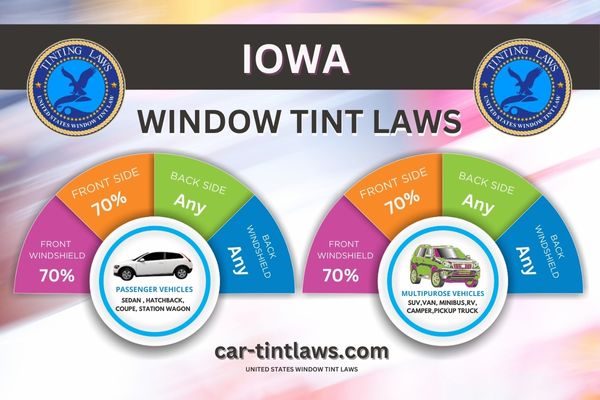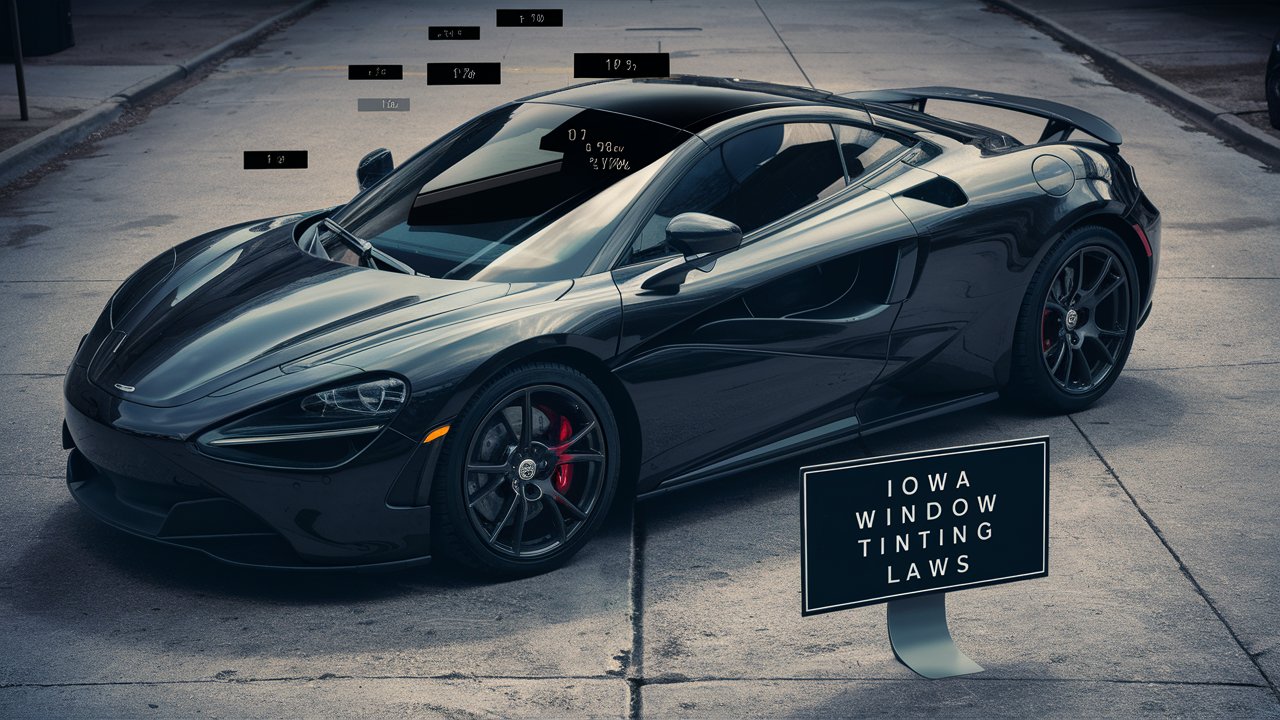When you’re considering window tinting for your vehicle in Iowa, it’s important to understand the state’s specific regulations to avoid hefty fines and promote road safety.
Iowa law requires front windows to allow over 70% light transmission, while back and rear windows can have a tint darkness up to 35%.
Reflective tints are a no-go, and certain colors like red, amber, and yellow are off-limits.
Did you know that medical exemptions for darker tints were discontinued in 2012?
There’s more to these rules than meets the eye, and comprehending them fully could save you a lot of trouble.
Window Tint Darkness in Iowa
When considering window tint darkness in Iowa, you’ll find specific regulations for sedans, SUVs, and vans.
For sedans, front windows must allow more than 70% of light in, while back and rear windows can have up to 35% tint darkness.
SUVs and vans follow the same rules for front windows but also permit 35% tint darkness for back side and rear windows.
Tint darkness for sedans:
- Windshield: Non-reflective tint is allowed on the top 6 inches of the windshield.
- Front Side windows: Must allow at least 70% of light in.
- Back Side windows: Must allow at least 70% of light in.
- Rear Window: Must allow at least 70% of light in.
To ensure compliance with Iowa’s tint darkness regulations for sedans, the front, back, and rear windows must have a minimum light transmission of 70%.
This requirement guarantees adequate Visible Light Transmission (VLT), enhancing safety and visibility while driving.
If you have a medical condition necessitating darker tint, you may be eligible for a window tint exemption, accommodating your specific health requirements with proper documentation.
Reflective tint is not permitted on sedan front windows or windshields in Iowa, ensuring no mirrored or metallic appearance that could cause glare or visual distractions for other drivers.
Moreover, Iowa law prohibits red, amber, or yellow tints on sedan windows to prevent confusion and visibility impairment, which are potential safety risks.
Failure to comply with these tint darkness regulations can result in fines and penalties, including a $127.50 fine, emphasizing the importance of adhering to these laws.
Tint darkness for SUV and Vans:
- Windshield: Only non-reflective tint is permitted on the top 6 inches of the windshield.
- Front Side windows: Light transmission of over 70% is required.
- Back Side windows: Any shade is acceptable.
- Rear window: Any tint darkness is allowed.
Window Tint Reflection in Iowa
When contemplating window tint reflection for sedans, SUVs, and vans in Iowa, you’ll need to be mindful of the state’s lack of specific regulations but also aware of potential visibility issues.
Excessive reflection might not be explicitly regulated, but it can lead to safety concerns, especially during traffic stops.
It’s important to balance your personal preferences with the need for clear visibility to guarantee both safety and compliance with law enforcement guidelines.
Tint reflection for sedans:
- Front Side windows: Iowa doesn’t require a reflective finish for sedans, but be cautious about excessive reflection to avoid inspections.
- Back Side windows: Excessive reflection might attract law enforcement’s attention, especially with darker tints, potentially leading to inspections or traffic stops.
- Compliance with Regulations: Ensure your window tint complies with Iowa’s laws, including visible light transmission percentages, to prevent issues with law enforcement.
Tint reflection for SUV and vans:
- Front Side windows: Must adhere to the same Visible Light Transmission (VLT) regulations as sedans to avoid legal issues.
- Back Side windows: Must comply with VLT percentages to ensure compliance with Iowa laws.
- Reflective Tint: Generally not allowed on SUVs and vans, although Iowa regulations do not specifically address this.
- Window Tint Manufacturers: Offer products that meet state laws, ensuring appropriate VLT percentages for vehicles.
- Medical Exemptions: Available for individuals with medical conditions requiring darker window tint, with proper documentation required.
- Compliance Importance: Understanding and complying with tint reflection requirements is crucial for SUV and van owners in Iowa.
- Legal Limits: Following guidelines ensures vehicles remain within legal boundaries, promoting community compliance and safety.
- Consultation: Always consult with manufacturers to confirm that tinting meets state standards.
Other Iowa window tint rules and regulations
- Medical Exemptions: After July 2012, Iowa discontinued medical exemptions for darker tints. However, if you had a medical exemption before this date, you can still maintain tint levels down to 35% VLT with appropriate documentation.
- Penalties: Violating Iowa window tint regulations can lead to fines and penalties. It is crucial to stay informed to avoid any legal issues.

Medical Exemptions for Window Tint Rules in Iowa
In accordance with Iowa’s window tinting laws, individuals with a medical necessity can maintain reduced transparency levels, provided they had the proper documentation before July 2012.
If you had your windows tinted for medical reasons before this date, you can keep the tint levels down to 35% Visible Light Transmission (VLT).
To qualify for this medical exemption in Iowa State, you must have Form 432020 signed by a physician before July 4, 2012.
The medical exemption form needs to include your name, a description of your medical necessity for reduced transparency, and an authorized medical provider’s signature.
If you lose your exemption form, you’ll need to obtain a new one from the Office of Vehicle and Motor Carrier Services.
Contact them at 515-237-3268 for any inquiries related to medical exemptions for window tinting.
It’s essential to keep this documentation with you at all times when driving.
This guarantees law enforcement can verify your compliance with Iowa State’s window tinting regulations.
Always stay informed and make sure your medical exemption is up-to-date to avoid any potential legal complications.
Iowa Window Tint Ticket Cost
A violation of Iowa’s window tint laws will cost you a fine of $127.50.
This penalty is imposed when your vehicle’s window tint does not comply with the specified Visible Light Transmission (VLT) percentages.
These percentages are set by Iowa Window Tinting Laws to guarantee safety and visibility for both drivers and law enforcement officers.
It’s important to understand that the window tint ticket cost isn’t just about the money.
It’s a deterrent designed to encourage adherence to the state’s tinting regulations.
By following these rules, you can avoid penalties and the legal consequences that come with non-compliance.
The VLT percentages indicate how much light must pass through your windows.
For example, Iowa law requires that the front side windows allow more light compared to the rear windows. This guarantees that interiors are visible, promoting safety on the road.
Iowa Vehicle Regulations Overview
When it comes to Iowa vehicle regulations, you’ll need to pay attention to tint percentage limits, legal tint levels, and enforcement and penalties.
Iowa law requires front windows to allow 70% light transmittance and prohibits reflective tint on all windows.
Understanding these details is essential to avoid fines and guarantee safe driving.
Tint Percentage Limits
Iowa’s vehicle regulations specify that front side windows on sedans must allow at least 70% of visible light to pass through.
This part of the law maintains that the light transmittance through these side windows keeps a level of visibility that is necessary for safe driving.
For the back side and rear windows, Iowa permits a lower visible light transmission (VLT) of 35%.
This means that these windows can be darker, giving you more flexibility if you prefer privacy or want to reduce glare from the sun.
However, it’s important to remember that reflective tint, which can create mirror-like surfaces, is strictly prohibited on all windows.
Reflective tints can cause visibility issues for both you and other drivers, which is why Iowa’s laws are strict on this matter.
Additionally, the state doesn’t allow red, amber, and yellow tints on car windows.
These colors can interfere with visibility and are not permitted under any circumstances.
Violating Iowa’s window tint laws can result in fines and penalties, so it’s important to adhere to these regulations to avoid any legal troubles.
By following these guidelines, you make sure your vehicle is both stylish and compliant with state laws.
Legal Tint Levels
Although tinting your car windows can enhance privacy and reduce glare, you must comply with Iowa’s specific legal tint levels to avoid fines and penalties.
According to state law, the front windows of your vehicle must allow at least 70% of light to pass through.
This means they can only be lightly tinted, guaranteeing that a significant amount of light still enters the vehicle.
For the back side and rear windows, the law permits a tint that allows a minimum of 35% light transmittance, providing more flexibility for those who seek greater privacy while still abiding by regulations.
Reflective tints are entirely prohibited on all windows in Iowa. This rule is in place to prevent excessive glare and ensure safety for all drivers on the road.
Additionally, the state law bans the use of red, amber, and yellow tints on car windows. These colors can cause visibility issues and confusion, which is why they are not permitted.
Enforcement and Penalties
Neglecting to adhere to Iowa’s window tinting regulations will incur a fine of $127.50.
Iowa’s state laws are explicit when it comes to enforcement, and understanding these regulations is vital to evade penalties.
If your vehicle’s windows are tinted beyond the permissible limits, you’re likely to face this fine.
Since July 4, 2012, medical exemptions for window tinting have been restricted under specific conditions, so it’s crucial to verify your tinting falls within the legal parameters.
Enforcement of these state laws is strict, aiming to uphold safety standards and visibility on the roads.
Law enforcement officers are diligent about checking window tints during routine traffic stops or vehicle inspections.
If they determine that your tint does not comply with the regulations, they will issue a citation, resulting in the specified fine.
Adhering to Iowa’s tint regulations not only helps you avoid fines but also contributes to overall road safety.
Non-compliance can lead to additional legal consequences, underscoring the importance of staying informed and compliant with state laws.
By following these rules, you guarantee a safer driving experience for yourself and others on the road.
References
Iowa Code Title VIII, Subtitle II, Section 321.438: Windshields and windows. (.pdf file)
Iowa Administrative Code – IAC Rule 761.450.7 – Front windshields, windows or sidewings
Iowa Department of Transportation – Window Tinting Standards
Frequently Asked Questions
What Is the Darkest Tint Legal in Iowa?
The darkest tint legal in Iowa is 35% VLT for back side and rear windows. Tint percentage limits are strictly enforced, so know the rules.
Besides looking cool, legal tinting benefits you by reducing glare and UV exposure.
Can I Be Pulled Over for Tinted Windows in Iowa?
Certainly, you can be pulled over for your tinted windows in Iowa if they don’t meet regulations.
While tinted windows offer privacy and style, staying within legal limits guarantees safety and avoids fines. Consider any exemptions applicable to you.
What Is the New Tint Law in Iowa 2024?
The new tint law in Iowa for 2024 lowers front window light transmittance to 25%.
There are tint exemptions, but enforcement concerns and the impact on safety during traffic stops are being addressed with potential amendments.
How Much Is a Tint Fine in Iowa?
Imagine your wallet as a fragile vase; a $127.50 tint fine can shatter it.
Tint fine consequences stem from strict tint enforcement practices, so understanding tint legality is essential to avoid penalties and stay within the community’s rules.
Conclusion
Following Iowa’s window tinting laws isn’t just about avoiding fines; it guarantees your vehicle is legally compliant and safe.
For instance, if John got his car windows tinted too dark, he might face a $127.50 fine during a routine traffic stop.
Remember, front windows must allow over 70% light transmission, and back windows can have up to 35% tint.
Reflective tints and certain colors are banned. Staying informed about these regulations helps you avoid legal issues.
